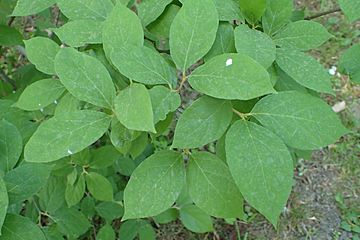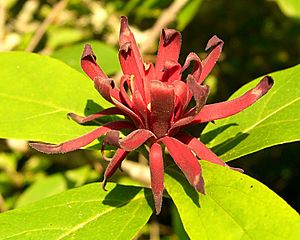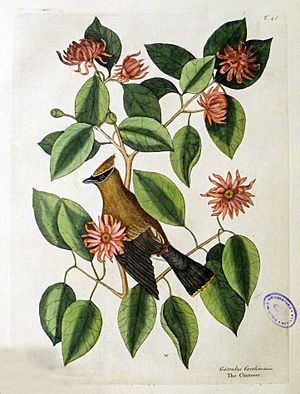Calycanthus floridus facts for kids
Quick facts for kids Calycanthus floridus |
|
|---|---|
 |
|
| Scientific classification | |
| Genus: |
Calycanthus
|
| Species: |
floridus
|
The eastern sweetshrub (scientific name: Calycanthus floridus) is a beautiful flowering plant. People also call it the Carolina allspice or spice bush because of its lovely smell. This plant is a type of shrub that belongs to the Calycanthaceae family. You can easily spot it by its dark red flowers and its wonderful, spicy scent. It grows naturally in the southeastern parts of the United States. Good news! Experts say it's not at risk of disappearing, meaning it's doing well in the wild.
Contents
What Does the Sweetshrub Look Like?
The eastern sweetshrub is a medium-sized plant, usually growing about 6 to 9 feet (around 2 to 3 meters) tall. Its leaves are a deep green on top and a lighter green underneath. They are shaped like an oval or an ellipse and can be up to 6 inches (about 15 cm) long. These leaves grow in pairs along the stem.
Sweet-Smelling Flowers
When spring arrives, the sweetshrub blooms with unique reddish-brown to reddish-purple flowers. These flowers grow one by one and have a strong, pleasant smell. Even the leaves smell nice if you gently crush them! The flowers have many petals that are long and narrow. Each flower has both male and female parts, allowing it to make seeds.
Fruits of the Sweetshrub
After the flowers, the plant produces fruits that look like small, hard pods. These fruits are about 3 inches (8 cm) long and 2 inches (5 cm) wide. Inside these pods, there are many small seeds, each about 10 mm long.
History and Naming
The eastern sweetshrub was first officially described by a famous scientist named Carl Linnaeus in 1759. He was the one who gave it the scientific name Calycanthus floridus. Linnaeus actually looked at an older drawing of the plant by an artist named Mark Catesby, which was published many years before.
Where Does the Sweetshrub Grow?
This plant is native to the eastern parts of the United States. It loves sunny places but can also grow well in areas with some shade. It prefers to grow in soil that stays moist.
What Is the Sweetshrub Used For?
People often plant the eastern sweetshrub in gardens because its flowers are very pretty and smell wonderful. The bark of the plant has been used as a substitute for cinnamon in some cases. Some people have also used the flower petals to make tea.
Important Safety Note: While some parts of the plant have been used, it's very important to know that parts of the sweetshrub contain substances that can be harmful if eaten. So, it's always best not to try eating any part of this plant.
Plant Health
The sweetshrub is quite strong and usually doesn't get many diseases or insect problems. However, it can sometimes get a disease called crown gall, which causes strange growths on its stems.
Images for kids
See also
 In Spanish: Calicanto de Carolina para niños
In Spanish: Calicanto de Carolina para niños





